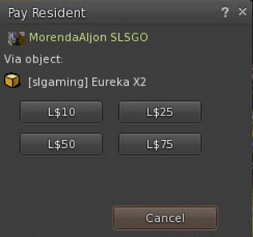If you play for e.g. L$20, you can win twice L$20 = L$40 when beating the target score.
Let's pay the game L$10 and start a game. I'll walk you through the game step by step.

If you play for e.g. L$20, you can win twice L$20 = L$40 when beating the target score.
Let's pay the game L$10 and start a game. I'll walk you through the game step by step.
Where to play?
Click a link to teleport directly to the Eureka! game machines.
Second Life Skill Gaming is only accessible within designated Skill Gaming Regions inside the Second Life platform. Access is restricted to individuals located in jurisdictions where skill gaming is legally permitted. Participation is not available to residents of Arizona, Arkansas, Delaware, Florida, Kentucky, Louisiana, Maryland, Michigan, Nevada, South Carolina, Tennessee and Utah. Void where prohibited.